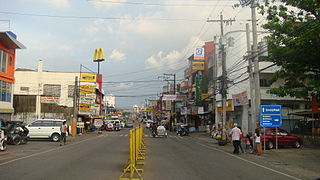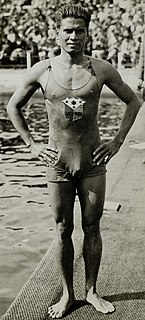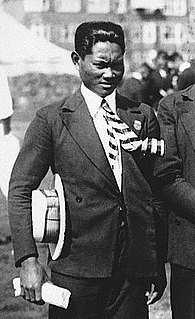Related Research Articles

The Philippines is an archipelago that comprises 7,641 islands with a total land area of 300,000 square kilometers (115,831 sq mi). It is the world's fifth largest island country. The eleven largest islands contain 95% of the total land area. The largest of these islands is Luzon at about 105,000 square kilometers (40,541 sq mi). The next largest island is Mindanao at about 95,000 square kilometers (36,680 sq mi). The archipelago is around 800 kilometers (500 mi) from the Asian mainland and is located between Taiwan and Borneo.

Ilocos Region is an administrative region of the Philippines, designated as Region I, occupying the northwestern section of Luzon. It is bordered by the Cordillera Administrative Region to the east, the Cagayan Valley to the northeast and southeast, and the Central Luzon to the south. To the west lies the South China Sea.

The Cordillera Central or Cordillera Range is a massive mountain range 320 km long north-south and 118 km east-west. The Cordillera mountain range is situated in the north-central part of the island of Luzon, in the Philippines. The mountain range encompasses all provinces of the Cordillera Administrative Region, as well as portions of eastern Ilocos Norte, eastern Ilocos Sur, eastern La Union, northeastern Pangasinan, western Nueva Vizcaya, and western Cagayan.

Vigan, officially the City of Vigan, is a 4th class component city and capital of the province of Ilocos Sur, Philippines. According to the 2020 census, it has a population of 53,935 people.

Anda, officially the Municipality of Anda, is a 3rd class municipality in the province of Pangasinan, Philippines. According to the 2020 census, it has a population of 41,548 people. The people of Anda generally speak Pangasinan, Bolinao, and Ilocano.
Bangui, officially the Municipality of Bangui, is a 4th class municipality in the province of Ilocos Norte, Philippines. According to the 2020 census, it has a population of 15,019 people.
Burgos, officially the Municipality of Burgos, is a 5th class municipality in the province of Ilocos Norte, Philippines. According to the 2020 census, it has a population of 10,759 people.
Piddig, officially the Municipality of Piddig is a 3rd class municipality in the province of Ilocos Norte, Philippines. According to the 2020 census, it has a population of 22,475 people.
Pinili, officially the Municipality of Pinili, is a 3rd class municipality in the province of Ilocos Norte, Philippines. According to the 2020 census, it has a population of 17,626 people.
Sarrat, officially the Municipality of Sarrat, is a 4th class municipality in the province of Ilocos Norte, Philippines. According to the 2020 census, it has a population of 25,186 people.

Bantay, officially the Municipality of Bantay, is a 3rd class municipality in the province of Ilocos Sur, Philippines. According to the 2020 census, it has a population of 37,118 people. It is situated just north-east of Vigan, the provincial capital.

Alaminos, officially the City of Alaminos, is a 4th class component city in the province of Pangasinan, Philippines, and is known for being the home of the Hundred Islands National Park, which is composed of 124 islands and is located off the coast of Barangay Lucap. According to the 2020 census, it has a population of 99,397 people. The city was named after Juan Alaminos y de Vivar, former Governor-General of the Philippines.

Lingayen, officially the Municipality of Lingayen, is a 1st class municipality and capital of the province of Pangasinan, Philippines. According to the 2020 census, it has a population of 107,728 people.
Dagupan, officially the City of Dagupan, is a 1st class independent component city in the Ilocos Region, Philippines. According to the 2020 census, it has a population of 174,302 people.

Teófilo E. Yldefonso was a Filipino breaststroke swimmer. He was the first Filipino and Southeast Asian to win an Olympic medal, and the first Filipino to win multiple medals.

The MacArthur Highway, officially the Manila North Road, is a 684.855-kilometer (425.549 mi), two-to-six lane, national primary highway and tertiary highway in Luzon, Philippines, connecting Caloocan in Metro Manila to Aparri in Cagayan. It is the second longest road in the Philippines, after Maharlika Highway. It is primarily known as MacArthur Highway in segments from Caloocan to Urdaneta, Pangasinan, although it is also applied up to Ilocos Sur, and likewise called as Manila North Road for the entire length.

Tuburan Kontong Tamse was a Filipino athlete, and the first Muslim Filipino Olympian.

The Metro Manila Subway, formerly known as the Mega Manila Subway (MMS), is an under-construction underground rapid transit line in Metro Manila, Philippines. The 36-kilometer (22 mi) line, which will run north–south between Quezon City, Pasig, Makati, Taguig, Parañaque and Pasay, consists of 15 stations between the East Valenzuela and Bicutan stations. It will become the country's second direct airport rail link after the North–South Commuter Railway, with a branch line to Ninoy Aquino International Airport.

The PNR North Main Line is one of the two trunk lines of the Philippine National Railways in the island of Luzon, the other being the PNR South Main Line. The line during its maximum extent led to various cities and municipalities in Central Luzon and the Ilocos Region.

The Teresa Magbanua-class patrol vessel is class of patrol vessels being built for the Philippine Coast Guard (PCG). The class is based on the Japan Coast Guard's Kunigami-class patrol vessel.
References
- ↑ "Mendoza: Quality Olympics finish for PHL". ph.news.yahoo.com. Retrieved 2021-08-23.
- ↑ "Guisit River stream, Ilocos, Philippines". ph.geoview.info. Retrieved 2021-08-22.
- ↑ "JICA報告書PDF版" (PDF). openjicareport.jica.go.jp.
- ↑ "Teofilo YLDEFONSO". Olympics.com. Retrieved 2021-08-23.
- ↑ "First Pinoy Olympic medalist has no known grave". Manila Bulletin. 2021-07-30. Retrieved 2021-08-23.
- ↑ "PH's first Olympic medalist Teofilo Yldefonso: An officer and a sportsman". l!fe • The Philippine Star. Retrieved 2021-08-23.